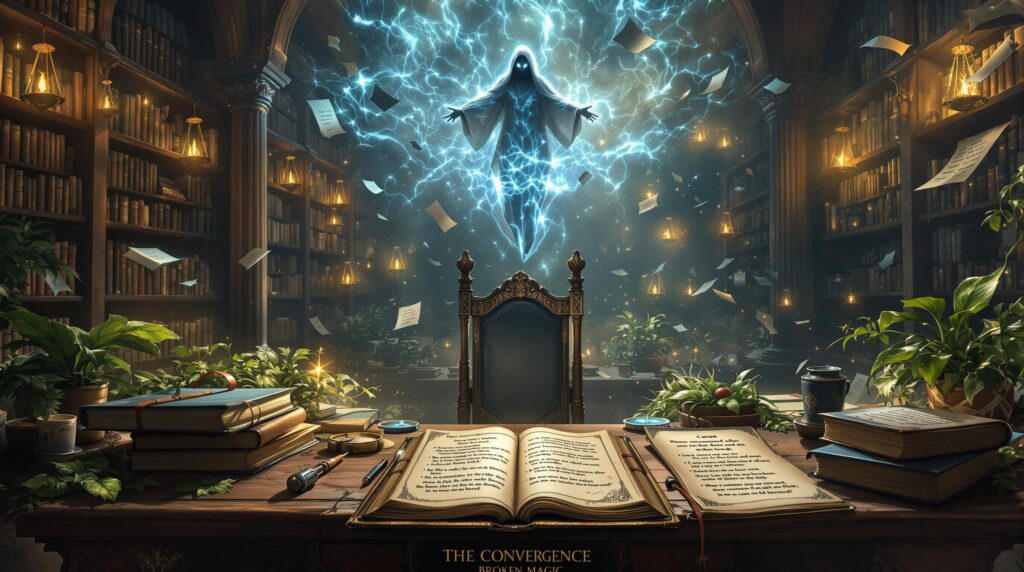Magic systems form the foundation of fantasy fiction, yet readers quickly identify inconsistencies. Skilled authors create more than impressive visual effects—they establish rules that generate story possibilities while imposing meaningful limitations. Richard French’s “The Convergence: Broken Magic” from Indie Pen Press demonstrates how magical systems with clear constraints create narrative tension while exploring deeper questions about power and responsibility. This post examines practical approaches to designing magic systems that enhance both story and substance.
The Rules-Consequences Connection in Magic Systems
Fantasy author Brandon Mull notes that established rules in magic systems give readers “something to hold onto” in unfamiliar worlds. Consistent rules do more than create logical coherence—they build reader trust. When audiences understand how magic functions, they can anticipate possibilities and appreciate clever solutions rather than feeling cheated by convenient powers that appear only when the plot requires them.
Magic systems with clearly defined limitations generate far more compelling narratives than those with unlimited power. Brandon Sanderson’s Allomancy in Mistborn exemplifies this principle by restricting magic users to specific metals that each grant distinct abilities. These constraints force characters to apply creativity within established boundaries rather than overwhelming obstacles with raw power.
In “The Convergence: Broken Magic,” Richard French demonstrates this principle effectively. The novel establishes that each magical act creates an imbalance that must eventually be reconciled. This fundamental restriction drives plot development as characters weigh the consequences of using their abilities. When the protagonist uses magic to save a child from drowning, the magical debt manifests as a gradually worsening drought, creating moral complexity around seemingly heroic actions.
Exercise: Drafting your magic system’s primary restrictions
Take 15 minutes to list three fundamental limitations of your magic system. Consider:
- Physical costs (energy depletion, aging, physical pain)
- Resource requirements (rare materials, specific conditions)
- Timing restrictions (phases of moon, specific hours)
- Knowledge barriers (years of study, ancient languages)
- Moral boundaries (karmic balance, ethical constraints)
For each limitation, brainstorm how characters might attempt to circumvent it, and what consequences might result from these attempts. Consistent magic systems begin with understanding these boundaries.
Cost and Consequence
Magic without cost creates narrative problems. The most engaging magic systems establish appropriate prices for power. This principle appears throughout both classic and contemporary fantasy—from the life-draining effect of the One Ring in Tolkien’s work to the emotional toll of “bone magic” in Leigh Bardugo’s Grishaverse.
Balancing magical power with appropriate sacrifices creates natural tension. The magnitude of cost should correspond to the power level—minor magic might cause small physical discomfort, while reality-altering magic could demand life-threatening sacrifices. This sliding scale keeps readers invested in characters’ decisions about when and how to use their abilities.
Magical costs typically fall into several categories:
- Immediate vs. cumulative: Does magic extract its price instantly or build up a debt over time?
- External vs. internal: Are the costs material resources or personal sacrifices?
- Temporary vs. permanent: Can the price paid be recovered, or is it a permanent loss?
- Individual vs. collective: Does the magic user alone bear the cost, or are others affected?
In “The Convergence,” French explores cumulative magical debt—characters can perform impressive feats in the moment, but the magical imbalance grows until it demands repayment, often in unexpected and dangerous ways. This approach creates suspense as readers anticipate when and how the magical reckoning will manifest.
Exercise: Designing meaningful consequences for your magic system
Choose one magical ability in your system and develop three potential costs:
- A physical/material cost
- A psychological/emotional cost
- A social/relational cost
Then consider how these costs might escalate as the power used increases. The most compelling magic systems balance power with meaningful sacrifice.

Magic Accessibility Spectrum
Who can access magic in your world fundamentally shapes your story’s social dynamics. Creating a magic system requires thoughtful consideration of what I call the “democratization spectrum”—the range from extremely limited magical access to universally available power.
At one end of this spectrum, magic might be restricted to a tiny elite—those born with rare genetic traits, descendants of specific bloodlines, or individuals who’ve undergone rare initiations. J.K. Rowling’s wizarding world exemplifies this approach, with magical ability determined at birth and unavailable to “muggles.” This creates natural social stratification.
At the spectrum’s other end, magic might be accessible to anyone willing to learn its principles, similar to how Patrick Rothfuss presents sympathy magic in his Kingkiller Chronicle, where proper training allows anyone to manipulate energy. This democratized approach raises different questions about education, resource allocation, and regulation.
The class implications of limited versus widespread magical ability are profound. Restricted magic systems often reflect or reinforce existing power structures. In “The Convergence,” French explores how magical ability concentrated in certain lineages has created a shadow aristocracy that manipulates political systems from behind the scenes. This mirrors real-world critiques of inherited privilege while giving them magical dimensions.
Exercise: Mapping who has access to magic in your world and why
Create a simple diagram showing:
- Who can access magic in your world (percentage of population)
- How access is determined (birth, training, divine selection, etc.)
- Whether access is binary (magical/non-magical) or exists on a spectrum
- How magical ability relates to existing social structures
- Whether access can change during a person’s lifetime
Your answers will reveal profound implications for your world’s social structures and provide rich ground for exploring themes of privilege, merit, and opportunity within your narrative.
Integration with Worldbuilding
Magic systems don’t exist in isolation—they interact with and shape every aspect of their worlds. Effective magic system creation demands seamless integration with economics, politics, religion, and daily life. The degree to which magic permeates everyday existence dramatically impacts worldbuilding.
Consider how magic might affect:
- Economics: Do magical products create new markets? Has magic replaced certain industries or created new ones?
- Politics: How do governments regulate magic? Do magical practitioners have special legal status?
- Religion: Is magic connected to divine powers or opposed by religious authorities?
- Daily life: How do ordinary people interact with magic in their routines?
Common pitfalls in magic-society integration include creating systems that would logically transform societies more than the author acknowledges. For instance, a healing magic that cures all diseases would revolutionize healthcare systems, population growth, and potentially warfare—yet authors sometimes introduce such magic without exploring these consequences.
Successful examples of organically integrated magic systems include N.K. Jemisin’s Broken Earth trilogy, where “orogeny” (earth-manipulation magic) shapes everything from architecture to family structures to governmental control systems. Similarly, in “The Convergence,” French shows how magical healing practices evolved alongside conventional medicine, creating a hybrid healthcare system with political tensions between traditionalists and innovators.
Exercise: Identifying three ways your magic system affects daily life
Choose three ordinary activities (cooking, transportation, communication, etc.) and describe how magic has influenced or changed these practices in your world. Consider:
- Is magic used directly in this activity?
- Has magic changed how people approach this activity?
- Are there conflicts between magical and non-magical approaches?
This exercise helps ensure your magic system feels genuinely integrated rather than superficially imposed on your world.
The Magic Origin Question
The origins of your magic system profoundly impact your story’s themes and possibilities. Authors must decide where their magic comes from and how much to explain these origins to readers. This decision places your work somewhere on what I call the “mystery-explanation spectrum.”
At one end of this spectrum, magic remains largely unexplained—a mysterious force whose workings remain enigmatic even to practitioners. This approach, exemplified in Tolkien’s Middle-earth, preserves a sense of wonder and the numinous. Magic feels ancient and somewhat unknowable, which can enhance its emotional impact.
At the spectrum’s other end, magic functions almost like an alternative science with clearly articulated principles. Brandon Sanderson’s approach to magic systems often leans toward this explanatory end, with magic following consistent, discoverable laws. This approach satisfies readers who enjoy understanding systems but risks diminishing magic’s mysterious qualities.
When to reveal magical background information depends on your narrative priorities. Information about magic origins might be:
- Known from the beginning (established worldbuilding)
- Gradually revealed (driving plot discovery)
- Central mystery (key to resolving the main conflict)
- Partially hidden (known to some characters but not others)
In “The Convergence,” French takes a middle approach—characters understand the mechanics of how magic functions, but its ultimate source remains contested between scientific and spiritual explanations. This tension mirrors the novel’s themes about knowledge, faith, and the limits of human understanding.
Exercise: Creating a magic origin that links to your story’s themes
Write a brief origin for your magic system that connects to one of your story’s central themes. For example:
- For themes of inequality: Magic emerged from a historical injustice
- For themes of environmental concern: Magic represents the world’s life force
- For themes of knowledge vs. intuition: Magic stems from discovering higher dimensions
Then decide how much of this origin is known to your characters versus your readers. Magic system limitations often derive directly from these origin stories, creating natural consistency.
Conclusion
Creating magic systems goes beyond inventing flashy abilities—it requires thoughtful consideration of rules, costs, and cultural integration. The most compelling magical worlds maintain internal consistency while reflecting meaningful themes. Start with clear boundaries, establish genuine consequences, and weave your magic deeply into your world’s fabric. Your readers will appreciate the solid foundation beneath the wonder, keeping them engaged long after the initial spectacle fades. Next month, we’ll explore how to build dystopian societies that mirror contemporary social issues while maintaining their own distinct identity.
Frequently Asked Questions
Should my magic system have a scientific explanation?
Not necessarily. Your magic system can exist anywhere on the spectrum from entirely mystical to quasi-scientific. What matters most is internal consistency and thematic resonance. Consider your target audience’s preferences and your story’s themes when deciding how much to explain.
How do I prevent my magic system from creating plot holes?
Document your magic system’s rules, limitations, and costs before writing significant plot points. Regularly review this documentation as you write. For each conflict, ask yourself, “Why couldn’t they solve this problem with magic?” If you can’t answer convincingly, either adjust your magic system or rethink your plot complication.
Can I mix different types of magic in one world?
Absolutely. Multiple magic systems can coexist in one world, often creating interesting tensions. Consider whether these systems share common origins or represent competing forces. Define how they interact, how practitioners of different systems view each other, and whether individuals can master multiple forms or must specialize.
How much detail about my magic system should I include in the story?
Include only what serves your narrative and enhances reader understanding. Reveal your magic system gradually through character experiences rather than exposition. Think of it as an iceberg—you should know far more about your system than you directly show to readers. The best magic systems feel deeper than what’s explicitly stated.
Sources:
Indie Pen Press
“The Convergence: Broken Magic”

